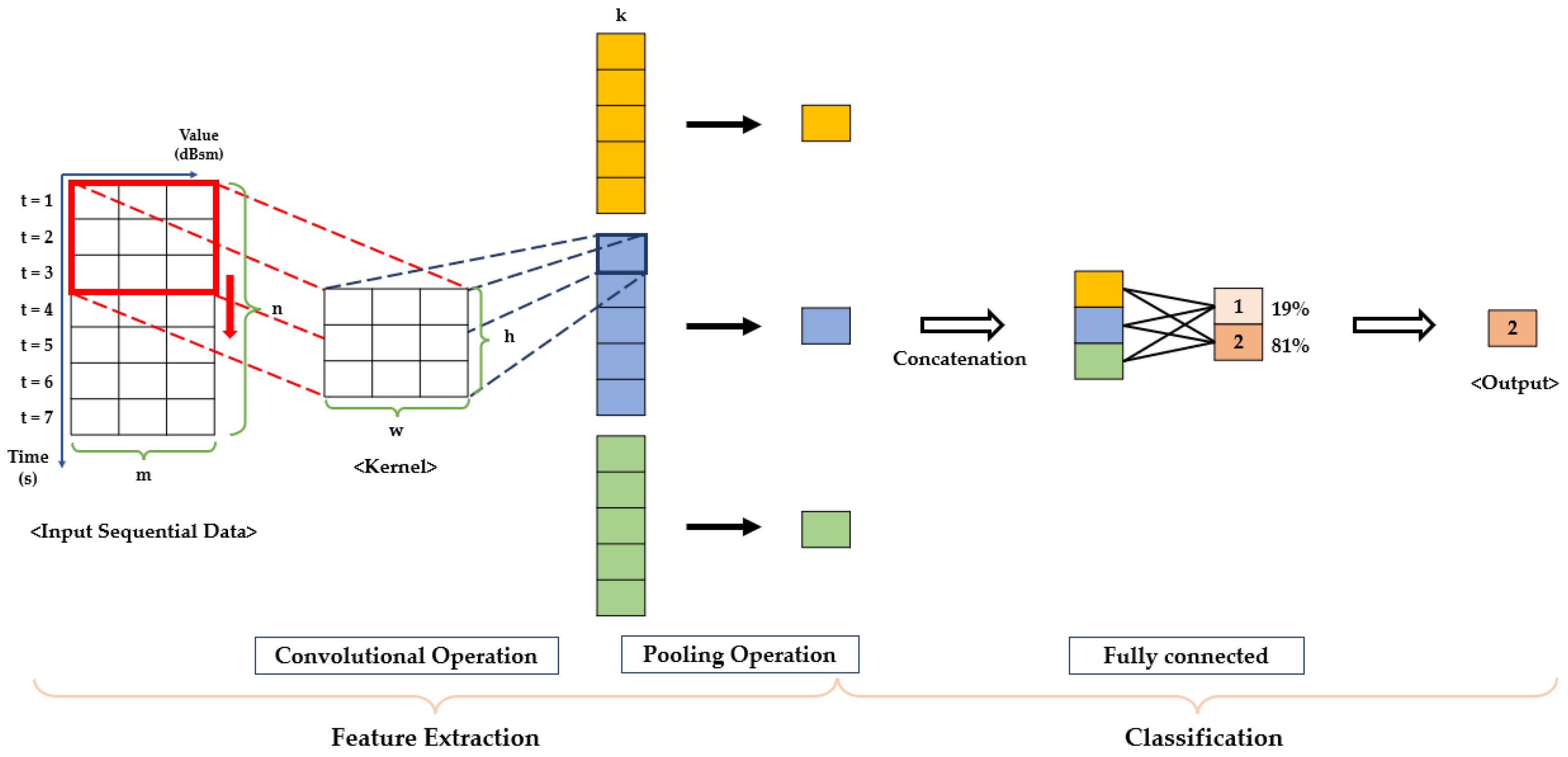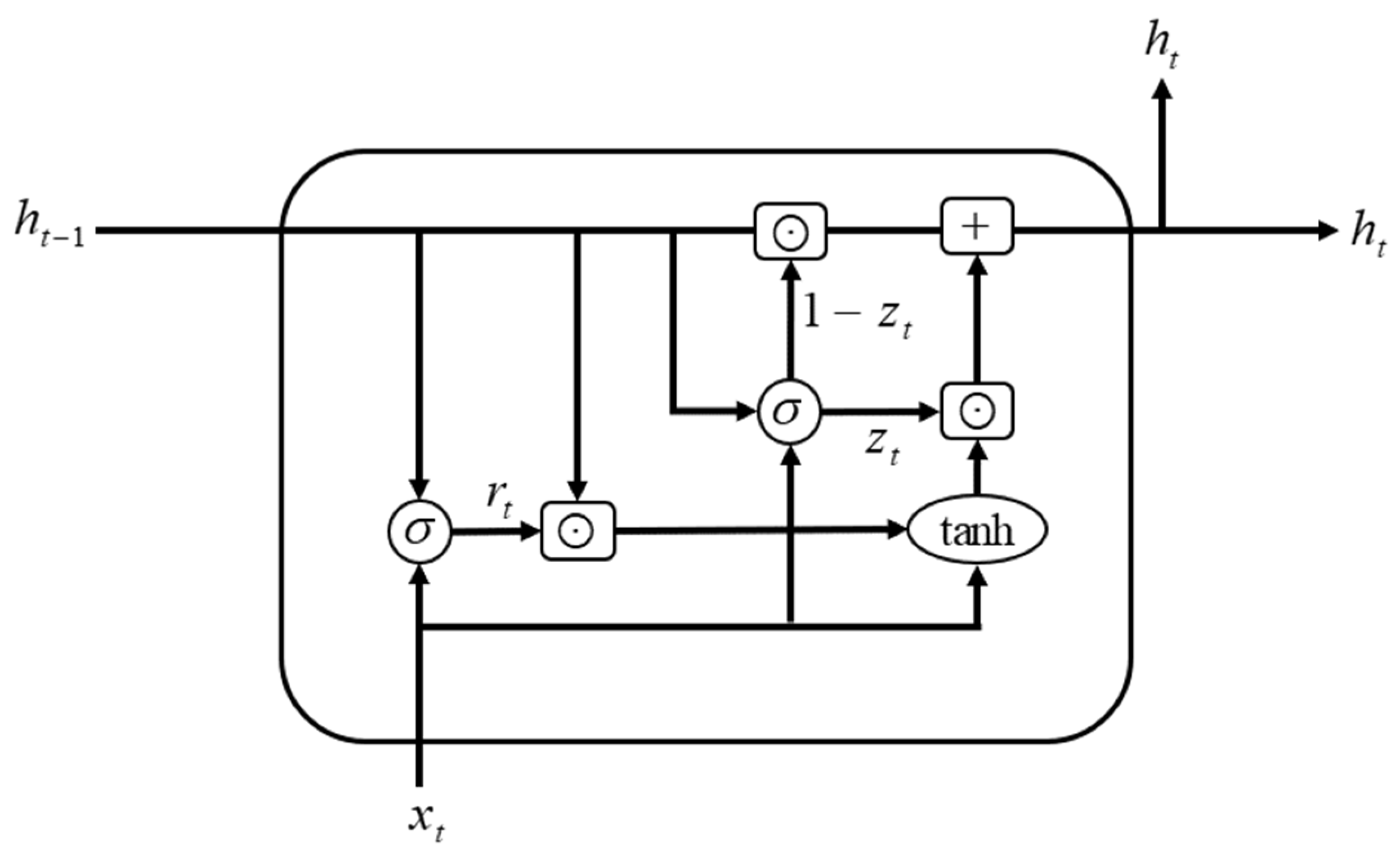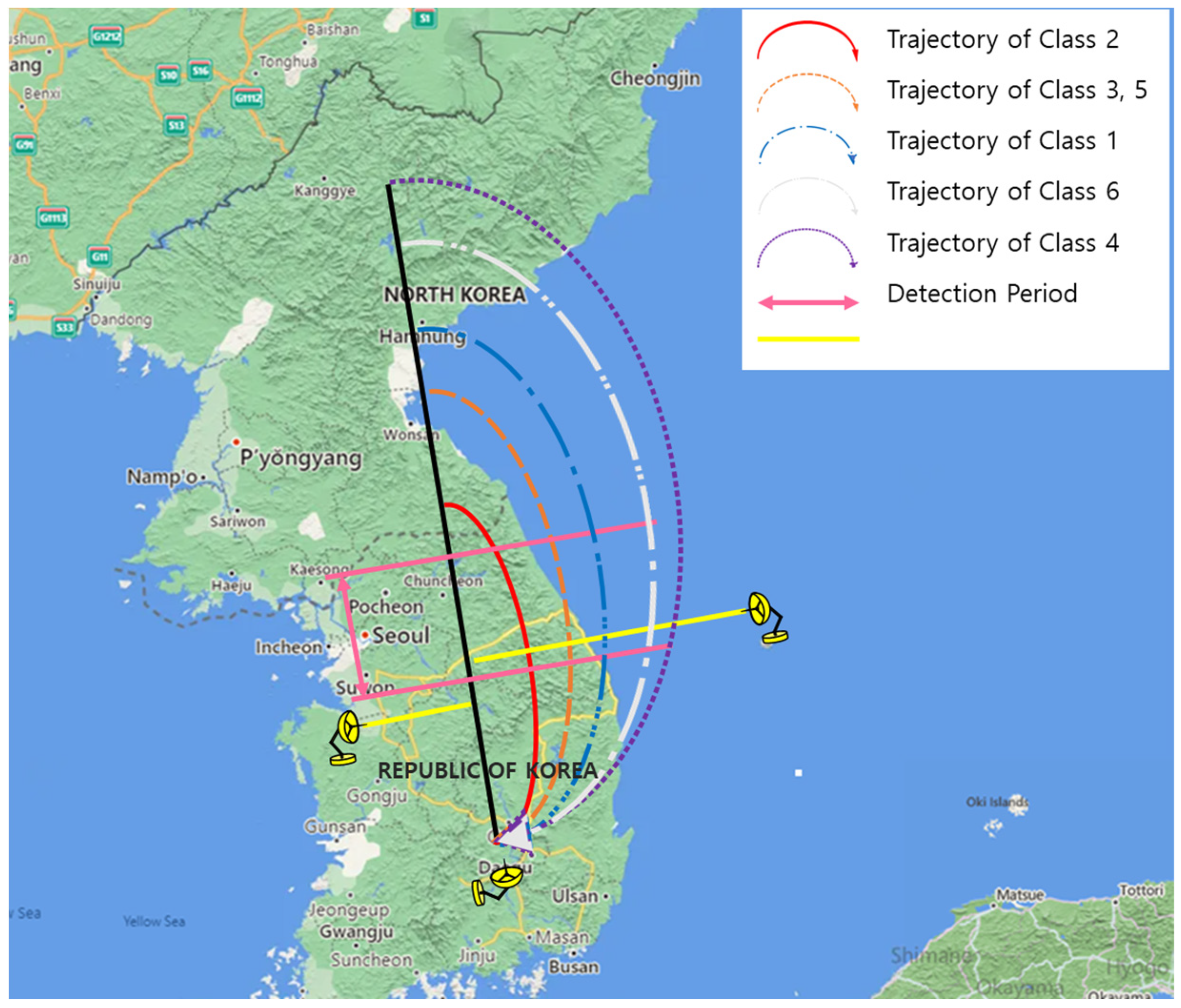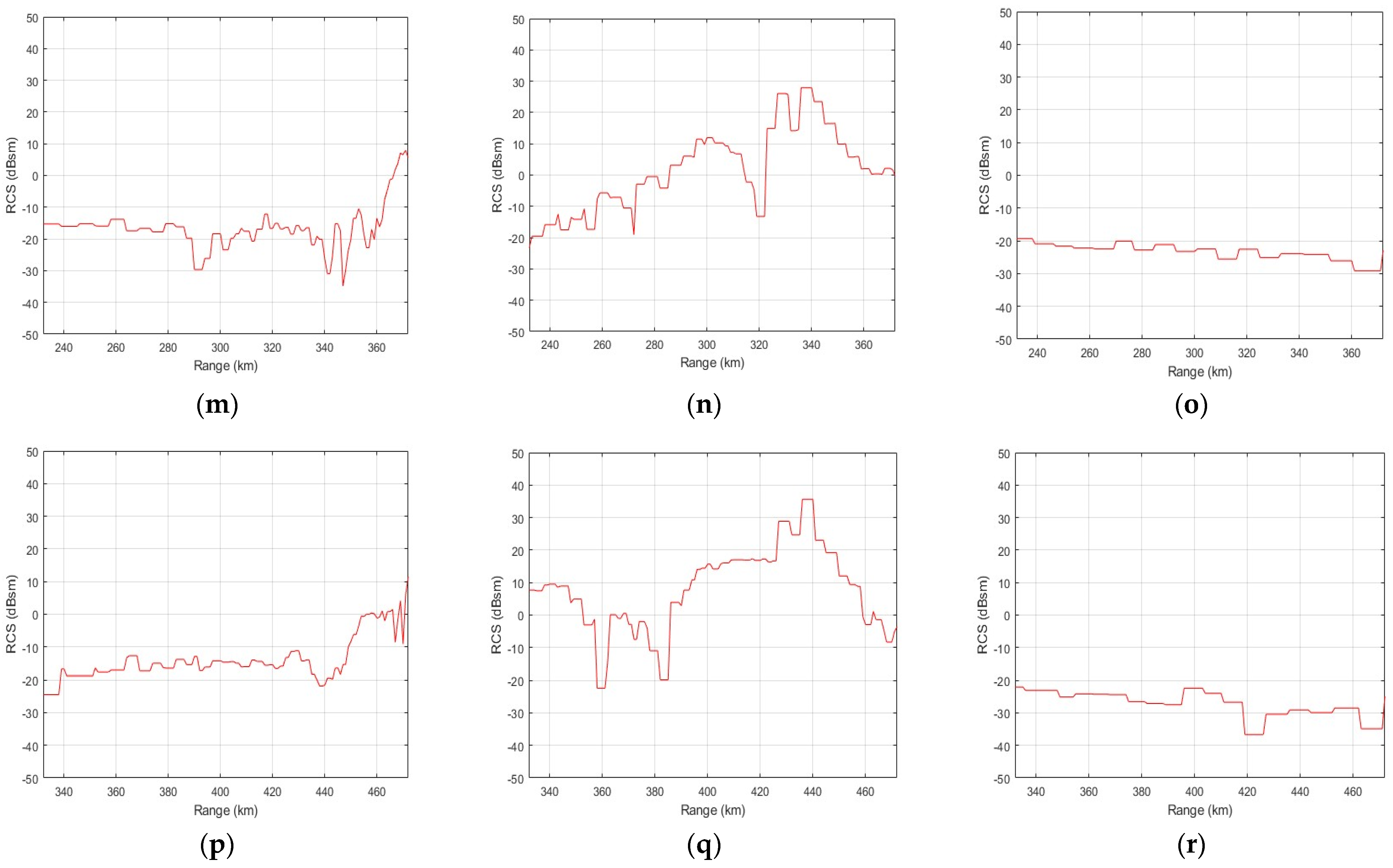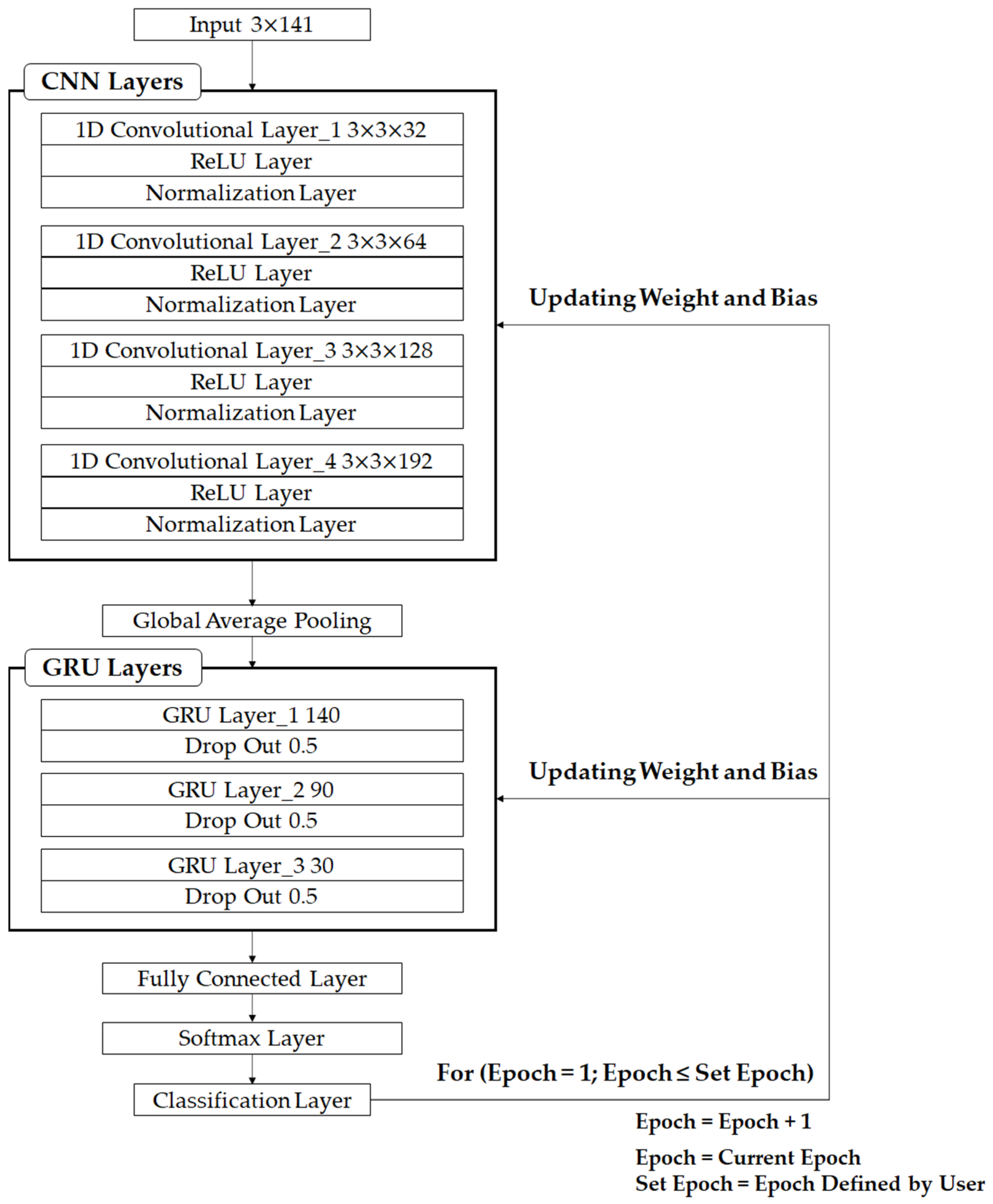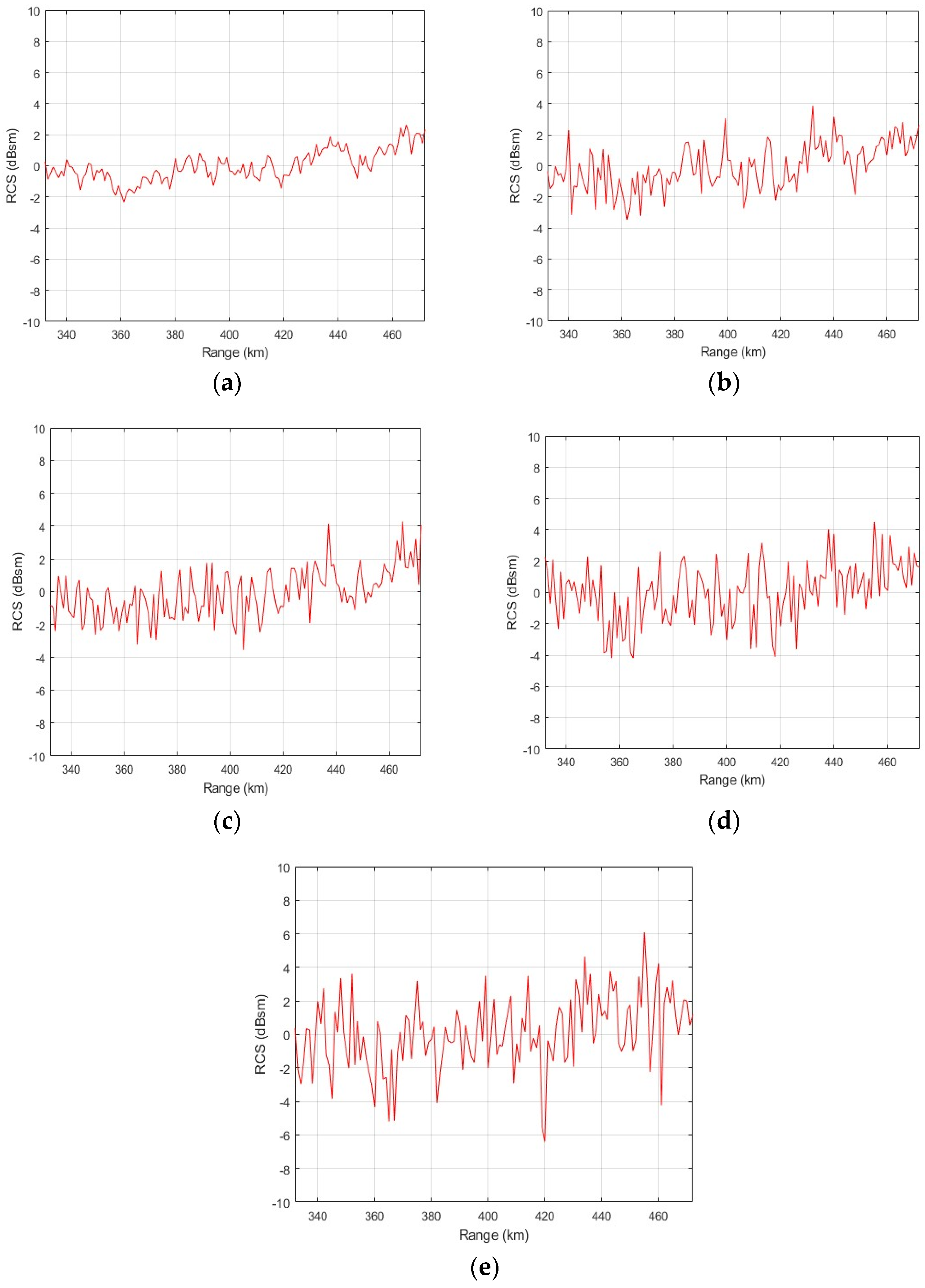1. Introduction
Countries that are adversaries continue to develop and test missiles, threatening the security of their neighboring countries. Accordingly, the importance of research related to the establishment of a missile defense system is increasing. In the defense system, quick and accurate judgment is important because making a wrong decision can lead to political and diplomatic problems. However, missiles are difficult to detect, classify, and intercept because their flight speed is fast and their shape and angle information varies depending on the flight stage. Therefore, in several countries, defense research is being carried out to ensure the stability and speed of operations by applying artificial intelligence (AI) technology to increase classification performance [
1,
2].
The quantity and quality of data are important for the application of AI technology, and it is important to collect and modify data sets that are suitable for using AI. For the above reasons, in the previous paper, radar measurements for target classification were analyzed initially [
3]. The radar measurement used for surface-to-air radar-based target classification is the radar cross section (RCS) [
4]. The reason that the RCS measurement is mainly used for classification is that it is time-series data, and the calculation speed is fast enough to be implemented in real-time. However, the RCS has the disadvantage of being vulnerable to noise [
5]. In addition, micro-Doppler appears in the RCS of a moving target, and the target’s feature vector extracted from the micro-Doppler signature is utilized in ballistic missile classification [
6,
7,
8,
9]. Micro-Doppler is the relative speed of the target to the radar and uses the Doppler frequency in which the radar signal is reflected.
Other types of radar data include the high-resolution range profile (HRRP) [
10,
11] and the inverse synthetic aperture radar (ISAR) [
12,
13] images. They can represent target shape information to improve classification performance and are also RCS-based data. The HRRP expresses the target’s scattering points as power according to the range through a two-dimensional graph, and the ISAR image expresses the target’s scattering points in the cross-range and range directions through a two-dimensional image. Unlike the RCS, HRRP and ISAR images contain the target’s size information, so classification performance can be improved. However, these are not suitable for AI data in a situation requiring real-time since they require a significant computation time due to a separate signal processing activity.
In previous research [
14], target classification was performed using the motion characteristics of the target rather than radar data such as the RCS. With the rapid development of computer performance, deep learning networks suitable for solving complex problems have been applied, and classification performance is continuously being improved through comparison and analysis [
4,
15]. Researchers in the defense field are making efforts to apply various AI techniques, which can improve RCS-based target classification performance for rapid and accurate target classification. In previous studies using RCS data, time-series networks were mainly used. First, radar data-based studies were conducted using a 1D convolutional neural network (CNN) with strengths in feature extraction. Chen, J., Xu, S., and Chen, Z. [
16] proposed the RCSnet by directly utilizing static RCS time-series data based on the 1D CNN to classify warheads and manned targets. Yao, X., Shi, X., and Zhou, F. [
17] proposed the CV-CNN applying the CNN structure. The authors performed a CV-CNN-based human activity classification using RCS data, showing a high classification accuracy of 99.81%. Additionally, long short-term memory (LSTM)-based target classification, a network used for time-series data processing, was also studied. Mansukhani, J., Penchalaiah, D., and Bhattacharyya, A. [
18] performed LSTM-based target classification using static RCS measurements of various targets extracted from simulations. Fu, R., Al-Absi, M. A., Kim, K. H., Lee, Y. S., Al-Absi, A. A., and Lee, H. J. [
19] showed a high detection accuracy of 99.88% through target classification of LSTM-based drones using millimeter-wave (mmWave) radars. In addition, an AI-based target classification study using HRRP—the radar data are not considered in this paper—was also conducted. Jithesh, V., Sagayaraj, M. J., and Srinivasa, K. G. [
20] used simulation-based HRRP of three different targets. They confirmed that classification without ambiguity is possible in the absence of noise through the LSTM–RNN-based target classification. A target identification study using a gated recurrent unit (GRU), which is known to have a higher learning efficiency due to having fewer parameters than the LSTM and has performance similar to that of the LSTM, has been conducted. Lu, W., Zhang, Y., Xu, C., Lin, C., and Huo, Y. [
21] proposed a new GRU-based satellite target recognition method using the HRRP.
Furthermore, different types of networks are combined to maximize each advantage. In the previous study, to improve the performance of time-series data classification, the CNN, which automatically extracts data features, and the LSTM and GRU, which extract temporal features between the extracted features, were combined and used. Zeng, K., Zhuang, X., Xie, Y., and Xi, Z. [
22] performed a 1D CNN–LSTM-based hypersonic vehicle trajectory classification using flight trajectories generated using aerodynamic characteristics as data. Liu, H., Ma, R., Li, D., Yan, L., and Ma, Z. [
23] conducted a 1D CNN–GRU-based rolling bearing failure diagnosis. As mentioned earlier, the 1D CNN–LSTM and the 1D CNN–GRU are mainly used in fields such as fault diagnosis and biosignals, but are rarely used in target classification using an RCS.
In this paper, we conduct a study to improve the AI-based target classification performance in a real-time situation using RCS data with noise. Previously, we performed the AI classification of missiles based on a 2D CNN using a static RCS and compared the classification with machine learning techniques such as the support vector machine (SVM) and k-nearest neighborhood (KNN). However, considering real-time target classification and actual situations of becoming variously noisy, we changed the data from the static RCS to the dynamic RCS and considered the network suitable for the dynamic RCS-like time-series data. Here, the 1D CNN–GRU network is selected to compensate for the disadvantage of the RCS, which is vulnerable to noise. In addition, extracting the dynamic RCS (DRCS) data of targets moving along the trajectory, simulating reality, is used as the AI data. Considering that the data have different characteristics, network optimization is required. Therefore, the 1D CNN–GRU network is optimized to be suitable for the generated dynamic RCS data. In this case, hyperparameters use the results analyzed in a previous study [
24]. Finally, the identification performance of the 1D CNN–GRU, according to the noise, is analyzed by comparing it with the 1D CNN and the 1D CNN–LSTM, which have been previously optimized.
An outline of this paper is as follows.
Section 2 introduces the background theory of the RCS and the networks for the time-series data processing.
Section 3 describes the data generation and configuration. In
Section 4, the optimization of the 1D CNN-based networks is performed, and the performance of the networks is compared and analyzed in
Section 5.
Section 6 summarizes the classification results and concludes with suggestions for future studies on improving the target classification performance.
6. Conclusions
After selecting radar data and networks to improve real-time target classification performance using surface-to-air radar, we designed the network and confirmed the classification performance. In addition, we considered the 1D CNN and 1D CNN–LSTM as comparison groups to confirm the designed network classification performance.
For real-time multiclass classification, the RCS, a radar measurement, was selected as input data. Although the RCS is capable of real-time acquisition, it has the disadvantage of being vulnerable to noise. To compensate for the shortcomings of the RCS, the 1D CNN–GRU, a combined network, was considered by adding a GRU layer for the more effective processing of time-series data to the 1D CNN with strong feature extraction strength. We designed a 1D CNN–GRU that has four convolutional layers and three GRU layers to fit the DRCS data characteristics. In the present study, the GRU hidden units consisted of 140, 90, and 30, and RMSprop as the optimizer was used. The designed network had the highest accuracy of 99.50%, confirming the best classification performance. In addition, with the network designed in this paper, the performance was checked as to whether target classification is possible for other RCS measurements. As a result of checking the classification performance based on the newly generated data set, the 1D CNN–GRU had the highest accuracy of 99.40%.
To select a network that could compensate for the weakness of the RCS, the noise was increased to check the classification performance according to the noise of the networks. We tested the existing data set and the new data set. At a low level of noise, the 1D CNN and the 1D CNN–GRU had slightly higher accuracies than the 1D CNN–LSTM, but the performance of all networks was high at a 98.93% accuracy. However, as the high level of noise was added, the accuracy of the combined networks of the 1D CNN–LSTM and 1D CNN–GRU was higher than that of the 1D CNN, with a standard deviation of 1.5 when using the existing data set and 1.0 when using the new data set. In addition, it was confirmed that the 1D CNN–GRU had the highest accuracy value at all noise levels in the two data sets. Based on the above results, it can be seen that the combined network is stronger in noise than the general network. Therefore, it was confirmed that the 1D CNN–GRU designed in this paper is suitable for RCS-based target classification by supplementing the shortcomings of the RCS.
By optimizing and designing, we proposed a 1D CNN–GRU that is less affected by noise and has high classification performance and learning efficiency. Furthermore, when the test was conducted by changing the type of missile, we confirmed a higher performance than other networks. As a result, we expect to enable an accurate and rapid preemptive response in the missile defense system by using the proposed network. In the future, our researchers will conduct a study to improve target classification performance after constructing various scenarios, including situations such as a low RCS and various different trajectories, such as pull-up maneuvers.
